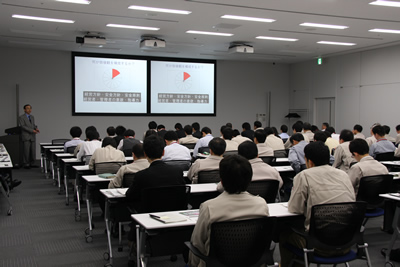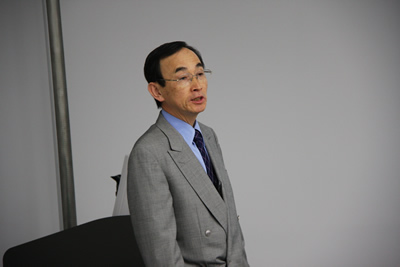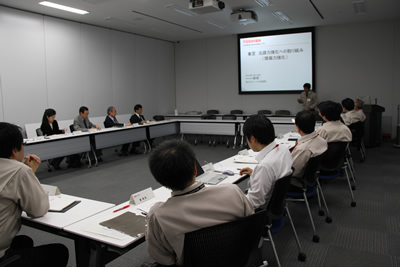|
|
 |
The 117th Safety Caravan was held at Toshiba’s Isogo Nuclear Engineering Center located in Isogo Ward, Yokohama in Kanagawa Prefecture on February 24, 2010. |
| Safety Presentation |

|
|
During the Safety Presentation
|
About 70 Toshiba employees attended the session.
Mr. Masahiko Kobayashi, head of Toshiba’s Isogo Nuclear Engineering Center, gave the opening address prior to the safety lecture.
“Today, we have invited the Japan Nuclear Technology Institute and Mr. Kunio Takekawa to come and hold a Safety Caravan session. This is the fifth such caravan which Toshiba has hosted and the third which has been held at the Isogo Nuclear Engineering Center. Mr. Takekawa’s lecture today will address the role which upstream departments (specifically engineering departments) play in ensuring on-site safety and in fostering safety culture. Currently, we are working to bolster our on-site capability (contractor capability)and are addressing the important issue of how not only field offices but also upstream departments can foster greater safety.
I anticipate that Mr. Takekawa will provide us with some valuable insight in this area, and I hope today that both his presentation and this afternoon’s information exchange session will contribute to all of us with consciousness to facilitating ongoing efforts aimed at increasing safety awareness.”
I hope today that both his presentation and this afternoon’s information exchange session will contribute to all of us with consciousness to facilitating ongoing efforts aimed at increasing safety awareness.
Following the opening address, Mr. Kunio Takekawa from Safety Culture Structuring Services Co., Ltd. gave a lecture entitled “Role of Upstream Departments (Engineering Departments) in Ensuring On-site Safety and Fostering Safety Culture.” |
| Summary
of presentation |

|
Mr. Kunio Takekawa
of Safety Culture Structuring Services Co., Ltd.
|
- A precondition of sustainable corporate management is stakeholder (e.g., employee, shareholder and customer) confidence and satisfaction, for which safety is fundamental.
- Corporate activity is undergirded by a variety of management systems; however, it is difficult to spread the management net wide enough in order to cover every activity. Corporate culture is what management systems are built on, filling in the “gaps” or “leakages” overlooked by management systems. And in the realm of safety, this corporate culture is known as “safety culture”.
- Culture is defined as “the totality of human lifestyle; the tangible and intangible totality built by humans,” and this “building” process requires a considerable amount of time.
- Stakeholders afford companies little temporal leeway in terms of their expectations and demands; a safety culture adapted to the expectations of stakeholders must be developed intentionally by a system making and show results in a relatively short amount of time.
- In order to build a safety culture in the face of such societal demands and environment, it is not enough to carry out thorough on-site safety management; there must be no conflict or contradiction between the activities of any of the company’s organizations or management systems and safety.
- Corporate activity can be analyzed from the four perspectives of values, role sharing, information and knowledge, and workplace conditions; each of these perspectives is further made up of thirteen different constituent elements.
For values, there are management/safety policies, safety principles and administrative and management motivation and leadership
For role sharing, there are management roles and responsibilities; safety personnel roles and expertise; and employee morale and job discipline
For information and knowledge, there are technical standards and work procedures and education and training
And for workplace conditions, there are safety targets and activity plans, health and safety committee functioning; two-way communication; accident/potential accident reporting and study; safety patrols and audits; and partner company management
All thirteen of these elements need to be addressed.
- Preventing equipment accidents that can cause disasters, such as fires, explosions and chemical material leaks, that not only affect workers but also have the potential to destroy facilities and significantly and negatively impact the local community, requires more than just strict adherence to the thirteen abovementioned elements. A systematic and exhaustive management structure must be built through the contribution and involvement of not only the production and maintenance departments but of the majority (all) departments. This system has fourteen control items.
- The final key element is “job regulation” for manager and employee; without this, any management system put in place will be little more than ideas on paper.
Some comments and response from the audience survey taken after the presentation:
- Thank you for a highly accessible talk. I really gained an understanding of the meaning, etc., of safety culture, and I learned a great deal about on-site equipment safety initiatives.
- I have tended to think of safety as something pertaining to on-site operations; however, today’s presentation has really opened my eyes to what safety means for the engineering department. In the engineering department I have always been conscious of specifications and technical standards aimed at ensuring quality, but now I will adopt the perspective of safety.
- Up until now I had only my own perspective as a reference for thinking about the importance of safety culture, but hearing a detailed presentation such as this has really deepened my understanding.
Safety is not something we preserve through individual awareness but, rather, through the creation of a climate of cooperation amongst employees and organizations. It is no wonder if said, and I was not usually conscious about it , and I am resolved to put it into practice.
- Because I work in an office removed from the actual production site, safety is not always at the forefront of my mind; however, this presentation has made me recognize the importance of safety awareness amongst upstream departments.
|
Safety information exchange session |

|
|
During the Safety information exchange session
|
Mr.Satoshi Fuchino, Field Engineering Manager of Toshiba’s Isogo Nuclear Engineering Center, gave a presentation on Toshiba’s initiative to enhance on-site capability. Also, Mr.Jun Hamada of the Japan Nuclear Technology Institute’s Nuclear Safety Network Division gave a presentation containing ideas for how to go about enhancing on-site capability. Following the presentations, the attendees exchanged ideas and opinions about this initiative and other topics. |
|
|







